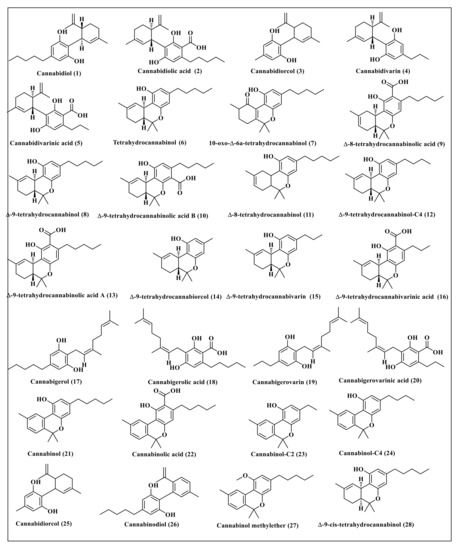
“Cannabis sativa L. is an annual herbaceous plant that belongs to the family Cannabinaceae. In this study, the potential use of forty-five cannabinoids, previously identified from Cannabis sativa to alleviate COVID-19 infection via prohibition of crucial SARS-CoV-2 proteins using molecular docking, was examined. In silico studies were performed on three vital enzymes that serve as principle therapeutic targets to prevent SARS-CoV-2 replication. These enzymes are the main protease SARS-CoV-2 MPro, papain-like protease SARS-CoV-2 PLpro and angiotensin-converting enzyme 2 (ACE2). Regarding SARS-CoV-2 MPro, cannabichromanon (32) showed the best fitting within its active centers, followed by cannabinolic acid (22) and cannabinol (21), displaying ∆G of -33.63, -23.24, and -21.60 kcal/mol, respectively. Concerning SARS-CoV-2 PLpro, cannabichromanon (32) followed by cannabinolic acid (22) and cannabicyclolic acid (41) revealed the best binding within its active pockets owing to multiple bond formation with ∆G values of -28.36, -22.81, and -19.89 kcal/mol. Furthermore, cannabichromanon (32), cannabinolic acid (22), and cannabinol (21) showed considerable fitting within the active sites of angiotensin-converting enzyme 2 (ACE2) evidenced by their significant ∆G values that were estimated as -41.77, -31.34, and -30.36 kcal/mol, respectively. ADME/TOPKAT (absorption, distribution, metabolism, excretion, and toxicity) evaluation was performed on the tested cannabinoids to further explore their pharmacokinetics, pharmacodynamics, and toxicity properties. The results indicated the considerable pharmacokinetic, pharmacodynamic, and toxicity properties of cannabinol (21), cannabinolic acid (22), cannabichromanon (32), and cannabicyclolic acid (41) that showed best fitting scores within the active sites of the tested enzymes. Multivariate data analysis revealed that cannabichromanon and cannabinolic acid showed a discriminant nature and hence can be incorporated in pharmaceutical dosage forms to alleviate COVID-19 infection.”
https://pubmed.ncbi.nlm.nih.gov/35566148/
https://www.mdpi.com/1420-3049/27/9/2797

